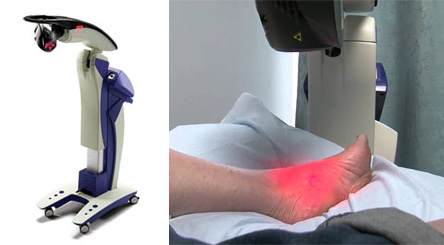Neuroma (Morton's)
 A neuroma is created by the thickening of nerve tissue and can develop throughout the body. In the foot, the most common neuroma is a Morton’s neuroma; this typically forms between the third and fourth toes. The thickening of the nerve is typically caused by compression and irritation of the nerve; this thickening can in turn cause enlargement and, in some cases, nerve damage.
A neuroma is created by the thickening of nerve tissue and can develop throughout the body. In the foot, the most common neuroma is a Morton’s neuroma; this typically forms between the third and fourth toes. The thickening of the nerve is typically caused by compression and irritation of the nerve; this thickening can in turn cause enlargement and, in some cases, nerve damage.
Neuromas can be caused by anything that causes compression or irritation of the nerve. A common cause is wearing shoes with tapered toe boxes or high heels that force the toes into the toe boxes. Physical activities that involve repeated pressure to the foot, such as running or basketball, can also create neuromas. Those with foot deformities, such as bunions, hammertoes, or flat feet, are more likely to develop the condition.
Symptoms of Morton’s neuroma include tingling, burning, numbness, pain, and the feeling that either something is inside the ball of the foot or that something in one’s shoe or sock is bunched up. Symptoms typically begin gradually and can even go away temporarily by removing one’s shoes or massaging the foot. An increase in the intensity of symptoms correlates with the increasing growth of the neuroma.
Treatment for Morton’s neuroma can vary between patients and the severity of the condition. For mild to moderate cases, padding, icing, orthotics, activity modifications, shoe modifications, medications, and injection therapy may be suggested or prescribed. Patients who have not responded successfully to less invasive treatments may require surgery to properly treat their condition. The severity of your condition will determine the procedure performed and the length of recovery afterwards.
MLS Laser Therapy
 MLS Laser Therapy stands for Multiwave Locked System Laser Therapy. This procedure is a minimally invasive procedure that targets pain points and reduces inflammation through the use of a laser light. The laser is used to penetrate the skin in an effort to reach those target areas that are causing the most discomfort. It then works towards healing wounds and repairing soft tissue.
MLS Laser Therapy stands for Multiwave Locked System Laser Therapy. This procedure is a minimally invasive procedure that targets pain points and reduces inflammation through the use of a laser light. The laser is used to penetrate the skin in an effort to reach those target areas that are causing the most discomfort. It then works towards healing wounds and repairing soft tissue.
This procedure is seen as a popular option among patients who would rather not go through surgery. MLS Laser Therapy has been found to be particularly useful in healing conditions such as neuroma, plantar fasciitis, diabetic ulcers, arthritis, and tendonitis. Those suffering from heel pain or dealing with a sports injury may find this type of treatment useful as well.
For more information about the treatment process of MLS Laser Therapy and to see if it’s the right option for your condition, we recommend you speak with our podiatrist for professional advice and care.




